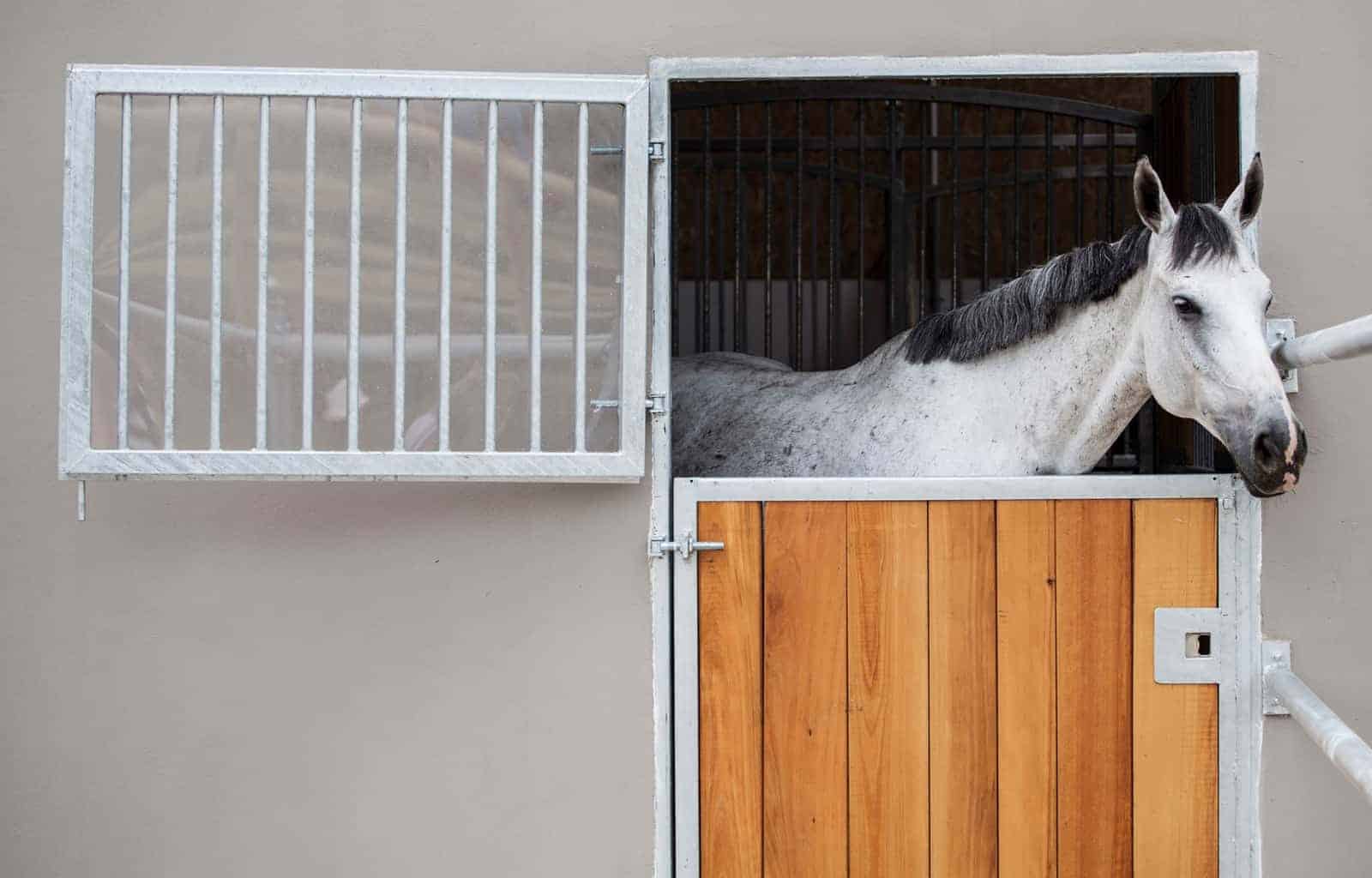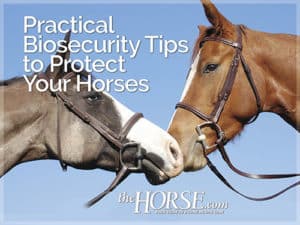Horse Farm Biosecurity

Reducing the risk and frequency of contagious equine disease outbreaks can be a challenge, but horse owners can help control introduction or spread of diseases, such as equine influenza, equine herpesvirus (EHV), or strangles, on their farms. Toward that end, Josie Traub-Dargatz, DVM, MS, Dipl. ACVIM, professor emeritus of equine medicine at Colorado State University, suggests horse owners read the USDA biosecurity brochure.
“This was written by a veterinary medical officer in New Jersey who had horses and was excerpted from a presentation she did for 4-H kids,” says Traub-Dargatz. “This veterinarian tried to address the ways disease could be introduced to your place or expose your horses, and what you can do to reduce these risks.”
As defined by the USDA, biosecurity means doing everything you can to reduce the chances of an infectious disease being carried onto your farm by people, animals, equipment, or vehicles, either accidentally or on purpose.
Reducing the Risks

“There are things you can do (to reduce the chances of introducing disease),” she says. “Doing any one of those will reduce the risk, but the question is by how much. When a farm has a mobile horse population, it is very difficult to completely eliminate introduction of disease agents.”
Horse owners need to realize there’s a difference between infectious and contagious disease. “Infectious disease may be caused by a pathogen that causes disease in the animal, but may not be contagious,” says Traub-Dargatz. “For instance, West Nile virus is not contagious horse-to-horse but strangles or influenza is. If it’s a contagious disease between horses, direct horse-to-horse contact poses the biggest risk.”
Exposure might occur at a show or trail ride, from horses across the fence, or a new horse brought to the farm.
Some farms have a buffer zone—a double fence between properties, with a lane between. “If horses cough across that air space, some diseases may spread, but at least it’s not nose-to-nose contact,” she says. “That’s the biggest risk. If horses are socializing across the fence, you and your neighbor should agree on a preventative medicine plan, so you are both on the same page regarding management for disease prevention. If your paddock is next to a public road, trail, or bridle path, this could be a bigger concern, and you might want to make sure your horses can’t get nose-to-nose with other horses that might be ridden by.”
Vaccination can be a critical aspect of controlling infectious diseases because in many instances owners can’t prevent exposure. “But remember that vaccination can’t prevent disease in all the animals, for all the diseases we are concerned about,” she says. “Vaccines perform better if we keep the disease challenge lower.”
Water sources can be an issue if your horses drink from a pond or ditch shared by neighboring horses, livestock, or wildlife. Some diseases such as leptospirosis and salmonellosis can be spread this way. It might be safest to have your horses drink from a waterer or tank where you have more control over the source and the delivery method.
Regarding physical separation of horses (of unknown disease status), many people wonder how far away and for how long a new horse should be kept separate from other horses on the farm. “For some diseases, if horses share an air space, they can be exposed,” states Traub-Dargatz. “Influenza, for instance, can be spread to other horses within 150 feet. That’s at least 10 stalls away. With a disease like strangles, it usually takes actual physical contact or shared water, tack, etc. Keep a new horse as far away as you can. It’s best if the horses don’t share the same air space (i.e., not in the same barn).”
This also helps with the next biggest risk–people going from horse-to-horse, inadvertently carrying pathogens.
Limiting Spread of Contagious Disease
Following is a synopsis of tips from the USDA’s biosecurity brochure for horse owners.
To reduce the risk of bringing home a disease if you are taking a horse somewhere and later returning him to the farm:
- Use your own trailer, and don’t haul any other horses besides your own.
- While away from home, don’t let your horse touch any other horse, and especially avoid nose-to-nose contact.
- Don’t share equipment.
- Wash hands after touching another horse.
- Don’t let strangers pet your horse.
- Before leaving the event, clean and disinfect your tack, equipment, etc.
- When you get home, shower and put on clean clothes and footwear.
When visiting other farms, shows, sales, and other places where there are horses:
- Have shoes/boots/clothing that you save for these occasions and don’t wear at home, or use shoe covers/plastic bags you can throw away.
- When working with horses on another farm, wear coveralls or change clothes after you get home, or make sure the other farm’s vaccination program or biosecurity is as good as your own.
For visitors to your farm:
- Have them park away from the horses, to keep pathogens from being tracked from vehicles or tires to your horses.
- If a farrier or veterinarian must park closer, make sure tires and shoes were disinfected.
- Give visitors plastic shoe covers (plastic bags will work) or brush off shoes and spray with disinfectant.
- If you have many visitors, as for a farm tour, use a foot bath.
Using disinfectants, which range from bleach to commercial veterinary/medical-grade products:
- Surfaces must be clean; brush off loose dirt/manure and wash with laundry detergent before using disinfectant.
- Clean grooming tools with detergent, rinse, then dip in disinfectant.
- Wipe tack with a disinfectant-dampened cloth. Take caution and ask a saddler about the best solution for this process.
- Bleach as a disinfectant: Use three-quarters of a cup per gallon of water (or one part bleach to 10 parts water) after completely cleaning dirt/manure from the item you’re disinfecting.
- Use commercial disinfectant sprays according to label instructions after dirt and manure are removed.
- Use other types of commercial disinfectants according to label directions.
- To create a footbath: use a disinfectant that works even when dirt and manure are present. Mix with water according to directions. Use in a shallow plastic pan or tub with a rough plastic (“fake grass”) doormat on the bottom for wiping and scraping shoes and boots. Change the liquid whenever it starts to get dirty.
“In the same barn, even if one horse is 10 stalls away, people are less likely to take enough precautions, just because they forget,” she says. By contrast, if the isolated horse is in a different barn or paddock, you’re more apt to remember to take precautions when moving between horses. We call this a functional barrier.
If visitors come to your farm, ask where they’ve been in case there’s a need for them to wash their hands or clean their footwear. “Have visitors check in before they have contact with your horses, especially if they were recently at another farm, or a sale, etc.,” she says.
“At a show or other public event, it’s difficult to keep people from petting horses,” notes Traub-Dargatz. “Whenever you take your horse somewhere, you are assuming a risk. When you bring those horses home, watch them carefully to see if they become sick.”
The extent of a disease outbreak on your farm from that exposed horse could be reduced if you take action quickly once illness is detected. There’s always some risk in taking horses off the farm, but the safest events are where all the arriving horses need a health certificate and vaccinations.
Isolating a Sick Horse
“It’s important to take temperatures on horses coming back from a show, since fever is often the first sign of disease,” states Traub-Dargatz. “By then, you are into the realm of trying to contain the disease rather than preventing it, since it’s already on your farm. But you may be able to reduce how many animals get sick, with appropriate action at that time.”
If a horse has fever, your initial response might be to move horses away from either side of him, but it’s possible that they’ve already been exposed (especially if it’s a respiratory disease) and, in that case, you are merely spreading the problem.
“Optimally, you would move the horse with the fever somewhere by himself, not with any other animals, and leave the exposed horses where they are, and monitor them–rather than moving them to another barn and possibly exposing the horses in the other barn,” she says.
Avoid Bringing Disease Home
It’s not just your horses that interact with other horses and carry diseases home. If you are interacting with horses that are not on your property, always wash your hands afterward. Horses can shed disease agents even if they look healthy.
“If you take your horse somewhere, take you own water buckets, don’t share equipment,” she advises. “When filling a bucket, don’t put the hose end into your bucket; hold it above the bucket.” If the hose end was recently in someone else’s water bucket, there might be pathogens on the outside of the hose.
People generally would never use the same bit that was used by another horse, but many forget that pathogens can be carried on other equipment, such as a wipe rag or grooming tool.
“Another thing you can do, depending on the event, is leave your horse by your own trailer (tied or in a portable pen) rather than in a stall that’s been used by many different horses,” notes Traub-Dargatz. “This is potentially less stressful for the horse, as well, since this is his own space he’s familiar with.”
This is definitely better than putting your horse in a pen next to a strange horse, especially if the two pens share a water source. The horse next door could leave secretions in the water that might be infective.
Take-Home Message
Prevention generally is easier than cleanup, especially when it comes to contagious diseases. Take these measures to reduce the likelihood of a disease hitting your farm.
Written by:
Heather Smith Thomas
Related Articles
Stay on top of the most recent Horse Health news with












